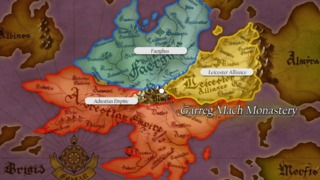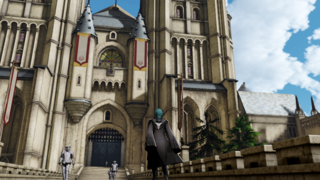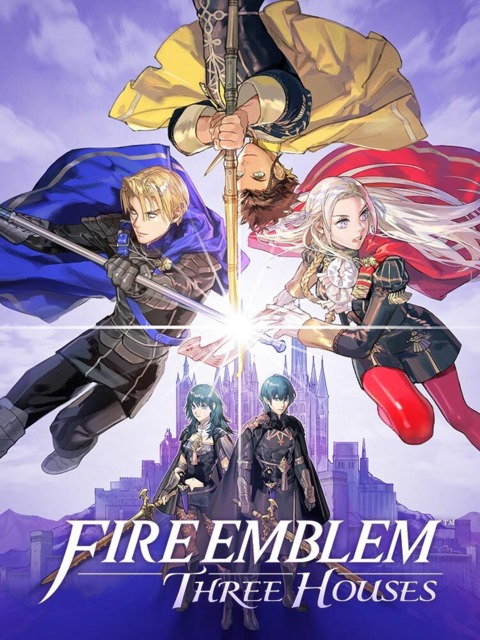SPOILER WARNING: This blog speaks at a very high level about mid-to-late game happenings in Fire Emblem: Three Houses. It's stuff that has been covered in other reviews and marketing materials, but I want to mention there are mild spoilers here just in case.
About two-thirds of my way through Fire Emblem: Three Houses, as I walked through the emptier-than-they-used-to-be halls of Garreg Mach Monastery, my mind filled with memories. I passed by Bernadetta’s room, and hoped she was happily eating cake somewhere. I walked into the blue lions’ old classroom, and wondered if Dedue was still happy serving as Dimitri’s retainer, or if Sylvain had ever changed his skirt-chasing ways. I fondly remembered chatting with Ashe, Caspar, Annette, and many other former students of the monastery (but not Hubert, dude has an attitude problem). I reminisced about holidays, events, and how bright the future seemed with so many bright students working and thriving together.
Little did I know, I would soon have to kill them all.
Fire Emblem: Three Houses is a case study on the inevitability of war and human conflict. It follows the citizens of Fodlan, a politically charged continent that is split into the titular three houses: black eagles, blue lions, and golden deer (the latter of which was my chosen house). Each house contains numerous students, and when combined with the other members of the monastery, as well as the many characters throughout Fodlan and its history, there are a lot of people to get to know in Three Houses. And what the game does so well, and so much better than previous Fire Emblem games I’ve played (which is all the ones officially released in the West), is make Fodlan truly feel like a living place full of diverse people with wildly differing beliefs and dreams; a realistic environment that breeds unfortunate but unavoidable conflict. Three Houses creates this environment in numerous ways. First, the characters are simply much more fleshed out than before; gone are the days where most of them are defined by a single, one-dimensional trait. Everyone I encountered in Three Houses has at least one substantial story arc past their initial quirk. And many of them turn out to have complicated thoughts and/or motives that intersect with other characters in fascinating ways. One small example among dozens: Lorenz began the game with the belief that nobles and commoners come from different worlds and cannot truly be friends (much less romantic partners), and he didn’t always treat commoners with proper respect as a result. But Dorothea, a commoner herself, pushed him to question what he had originally accepted as self-evident. By the end they were indeed friends, and Lorenz had a new perspective. I was genuinely surprised more than once at the depths of these characters, and consistently delighted to see them all interact in meaningful ways.

Second, you are exposed to Fodlan’s extensive history and geopolitical structure more than the comparable locations of previous games. Right from the start, you can peruse the monastery’s library to learn about a wide array of historical topics: the forming of the Church of Seiros, which is the continent’s central guiding religion (and borderline oligarchy); the conflicts that led to the formation of the titular three houses; an ancient, bloody war between Seiros and a bandit named Nemesis; Fodlan’s various noble houses and their leaders; how certain individuals are born with crests that enable them to wield powerful relics (which ties into Foldan’s power structure); and on and on. More importantly, all of these topics and then some are further expounded upon throughout the course of the game. They are revealed naturally through your interactions with other characters, and just how many details you are exposed to varies wildly depending on which house you choose to join, and which characters you choose to spend your time with. This isn’t a game that delivers every bit of information to you by its end, regardless of context. It understands that the world is a big, complicated place, and that no one person will see every angle of it. As such, every character is shaped drastically by what knowledge and experiences they are exposed to, and that importantly includes you. There are secrets, struggles, and relationships I never encountered in my playthrough, and that’s OK. It made the ones I did encounter feel more real, just as everyone’s limited experiences in our world shape them in very real ways. You experience a lot in a single playthrough of Three Houses, yet it is still but a single view of life in Fodlan.
Three Houses doesn’t shy away from complicated and worldly topics either, very real ones that lead to conflicts including racism, the inequality of class, or the church’s abuse of knowledge and power. And unlike most video games, it presents actual conversations around these topics where the characters involved have things to say and actions to take. They have firmly rooted beliefs formed through their life experiences and the powerful cultural dynamics in play. As the game goes on, and various characters have their beliefs and trust challenged, they decide to act, which naturally causes conflict. The detail in its characters and world make it impossible to avoid the parallels to our actual, real world history, and that’s precisely why these conflicts feel wholly believable. Three Houses is not about black and white “good guys vs. bad guys,” in the way that some Fire Emblem games have (somewhat cartoonishly) been. Rather, Three Houses operates in perpetual gray, showing how people from different walks of life clash in very much the same ways they always have. The (usually strong) writing helps a lot here, which consistently caught me off guard in the way it develops intrigue and reveals poignant information. It’s a game that knows what it’s doing, and likes to constantly remind you as much in clever ways. One of my favorite examples: everyone’s starting class is mechanically identical, but is called either “Noble” or “Commoner” depending on their social standing. It’s subtle, but it absolutely means something.

Finally, and perhaps most importantly, Three Houses’ new structure does wonders for its narrative trappings. Fire Emblem has always provided great tactical battles, and has always had endearing characters (and sometimes interesting plots too). Yet I never became invested in the narrative like I did here. This is a long game, but that length feels necessary to flesh out a world as complex as this: spending time every month roaming the monastery gives the narrative breathing room to develop. I got to know the characters better as they reacted to every mission. The plot could slowly but steadily build in a way that neither too rushed nor too lingering. How you choose to spend your limited time each month imparts a real weight on the actions you do take. It also allowed for the feeling that time was passing, which in subtle but important ways made me feel like I was part of this world. I became more invested mechanically too, in the way I could manually instruct students and guide their growth in the game’s many skills and classes. Three Houses is much more divergent and hands on than any previous Fire Emblem game, and over time that created a real sense of pride in the students I had recruited and trained. Rather than everyone being hardened veterans at the start, who follow predetermined upgrade paths, we spent months honing our skills and improving. I watched these students grow, both on and off the battlefield, and the effect was powerful. Three Houses took a big risk by adding so much time spent outside of the series’ famous tactical battles (which are still great by the way). But the result is one of my favorite hubs in any game I’ve played; within the large, complex, and sometimes frighteningly overwhelming land of Fodlan, Garreg Mach Monastery came to feel like home to me. I cherish my time there greatly, and thinking back to the early hours of my game is now almost nostalgic.
That nostalgia is perhaps Fire Emblem: Three Houses’ greatest gift and its most wrenching curse, as well as its most profound artistic achievement. As I walked through the halls of Garreg Mach Monastery one last time, and think of all those happy early memories, I can’t escape the sad memories that follow; its halls now entomb stolen time more than anything. The edge of dawn only brought pain and sorrow, as the memories of war and bloodshed tainted the peace we once had. But the lesson is that it always does, and among the characters and history of Fodlan, it finally felt all too real.

Log in to comment